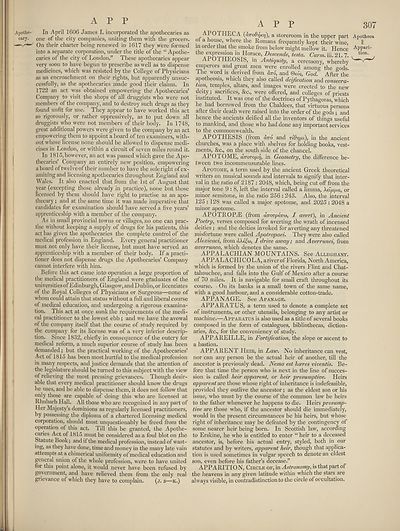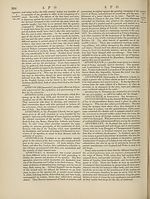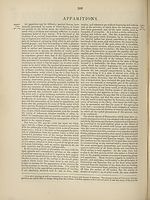Encyclopaedia Britannica > Volume 3, Anatomy-Astronomy
(315) Page 307
Download files
Complete book:
Individual page:
Thumbnail gallery: Grid view | List view

A P P
Apothe- In April 1606 James I. incorporated the apothecaries as
cary. 0ne of the city companies, uniting them with the grocers.
■—On their charter being renewed in 1617 they were formed
into a separate corporation, under the title of the “ Apothe¬
caries of the city of London.” These apothecaries appear
very soon to have begun to prescribe as well as to dispense
medicines, which was resisted by the College of Physicians
as an encroachment on their rights, but apparently unsuc¬
cessfully, as the apothecaries made good their claims. In
1722 an act was obtained empowering the Apothecaries’
Company to visit the shops of all druggists who were not
members of the company, and to destroy such drugs as they
found unfit for use. They appear to have worked this act
so rigorously, or rather oppressively, as to put down all
druggists who were not members of their body. In 1748,
great additional powers were given to the company by an act
empowering them to appoint a board of ten examiners, with¬
out whose license none should be allowed to dispense medi¬
cines in London, or within a circuit of seven miles round it.
In 1815, however, an act was passed which gave the Apo¬
thecaries’ Company an entirely new position, empowering
aboard of twelve of their number to have the sole right of ex¬
amining and licensing apothecaries throughout England and
Wales. It also enacted that from the 1st of August that
year (excepting those already in practice), none but those
licensed by them should have right to practise as an apo¬
thecary ; and at the same time it was made imperative that
candidates for examination should have served a five years’
apprenticeship with a member of the company.
As in small provincial towns or villages, no one can prac¬
tise without keeping a supply of drugs for his patients, this
act has given the apothecaries the complete control of the
medical profession in England. Every general practitioner
must not only have their license, but must have served an
apprenticeship with a member - of their body. If a practi¬
tioner does not dispense drugs the Apothecaries’ Company
cannot interfere with him.
Before this act came into operation a large proportion of
the medical practitioners of England were graduates of the
universities of Edinburgh, Glasgow, and Dublin, or licentiates
of the Royal Colleges of Physicians or Surgeons—none of
whom could attain that status without a full and liberal course
of medical education, and undergoing a rigorous examina¬
tion. This act at once sunk the requirements of the medi¬
cal practitioner to the lowest ebb; and we have the avowal
of the company itself that the course of study required by
the company for its license was of a very inferior descrip¬
tion. Since 1832, chiefly in consequence of the outcry for
medical reform, a much superior course of study has been
demanded; but the practical working of the Apothecaries’
Act of 1815 has been most hurtful to the medical profession
in many respects, and justice demands that the attention of
the legislature should be turned to this subject with the view
of relieving the most pressing grievances. Though desir¬
able that every medical practitioner should know the drugs
he uses, and be able to dispense them, it does not follow that
only those are capable of doing this who are licensed at
Rhubarb Hall. All those who are recognized in any part of
Her Majesty’s dominions as regularly licensed practitioners,
by possessing the diploma of a chartered licensing medical
corporation, should most unquestionably be freed from the
operation of this act. Till this be granted, the Apothe¬
caries Act of 1815 must be considered as a foul blot on the
Statute Book; and if the medical profession, instead of wast¬
ing, as they have done, time and money in the many late vain
attempts at a chimerical uniformity of medical education and
general union of the whole profession, were to have united
for this point alone, it would never have been refused by
government, and have relieved them from the only real
grievance of w hich they have to complain. (j. s—k.)
A P P 307
APO1HECA (airoOrjiaj), a storeroom in the upper part Apotheca
of a house, where the Romans frequently kept their wine, II
in order that the smoke from below might mellow it. Hence APPari-
the expression in Horace, Descende, testa. Carm. iii. 21.7. tion-
APOTHEOSIS, in Antiquity, a ceremony, whereby
emperors and great men were enrolled among the gods.
The word is derived from d7ro, and ©eos, God. After the
apotheosis, which they also called deification and consecra¬
tion, temples, altars, and images were erected to the new
deity; sacrifices, &c., were offered, and colleges of priests
instituted. It was one of the doctrines of Pythagoras, which
he had borrowed from the Chaldees, that virtuous persons
after their death were raised into the order of the gods ; and
hence the ancients deified all the inventors of things useful
to mankind, and those who had done any important services
to the commonwealth.
APO THESIS (from airo and TLOrj/u), in the ancient
churches, was a place with shelves for holding books, vest¬
ments, &c., on the south side of the chancel.
APOTOME, dTroTOfirj, in Geometry, the difference be¬
tween two incommensurable lines.
Apotome, a term used by the ancient Greek theoretical
writers on musical sounds and intervals to signify that inter¬
val in the ratio of 2187 : 2048, which, being cut off from the
major tone 9 : 8, left the interval called a limma, Xei/xfia, or
minor semitone, in the ratio 256 : 243. Also, the interval
125 : 128 was called a major apotome, and 2025 :2048 a
minor apotome.
APOTROPiE (from aTrorpeTTO), I avert), in Ancient
Poetry, verses composed for averting the wrath of incensed
deities ; and the deities invoked for averting any threatened
misfortune were called Apotropaei. They were also called
Alexicaci, from dXe^w, I drive away; and Averrunci, from
averrunco, which denotes the same.
APPALACHIAN MOUNTAINS. See Alleghany.
APPALACHICOLA, a river of Florida, North America,
which is formed by the union of the rivers Flint and Chat-
tahouchee, and falls into the Gulf of Mexico after a course
of 70 miles. It is navigable for small craft throughout its
course. On its banks is a small town of the same name,
with a good harbour, and a considerable cotton-trade.
APPANAGE. See Apanage.
APPARATUS, a term used to denote a complete set
of instruments, or other utensils, belonging to any artist or
machine.—Apparatus is also used as a title of several books
composed in the form of catalogues, bibliothecas, diction¬
aries, &c., for the conveniency of study.
APPAREILLE, in Fortification, the slope or ascent to
a bastion.
APPARENT Heir, in Law. No inheritance can vest,
nor can any person be the actual heir of another, till the
ancestor is previously dead. Nemo est Imres viventis. Be¬
fore that time the person who is next in the line of succes¬
sion is called heir apparent, or heir presumptive. Heirs
apparent are those whose right of inheritance is indefeasible,
provided they outlive the ancestor; as the eldest son or his
issue, who must by the course of the common law be heirs
to the father whenever he happens to die. Heirs presump¬
tive are those who, if the ancestor should die immediately,
would in the present circumstances be his heirs, but whose
right of inheritance may be defeated by the contingency of
some nearer heir being born. In Scottish law, according
to Erskine, he who is entitled to enter “ heir to a deceased
ancestor, is, before his actual entry, styled, both in our
statutes and by writers, apparent heir, though that applica¬
tion is used sometimes in vulgar speech to denote an eldest
son, even before his father’s decease.”
APPARITION, Circle of, in Astronomy, is that part of
the heavens in any given latitude within which the stars are
always visible, in contradistinction to the circle of occultation.
Apothe- In April 1606 James I. incorporated the apothecaries as
cary. 0ne of the city companies, uniting them with the grocers.
■—On their charter being renewed in 1617 they were formed
into a separate corporation, under the title of the “ Apothe¬
caries of the city of London.” These apothecaries appear
very soon to have begun to prescribe as well as to dispense
medicines, which was resisted by the College of Physicians
as an encroachment on their rights, but apparently unsuc¬
cessfully, as the apothecaries made good their claims. In
1722 an act was obtained empowering the Apothecaries’
Company to visit the shops of all druggists who were not
members of the company, and to destroy such drugs as they
found unfit for use. They appear to have worked this act
so rigorously, or rather oppressively, as to put down all
druggists who were not members of their body. In 1748,
great additional powers were given to the company by an act
empowering them to appoint a board of ten examiners, with¬
out whose license none should be allowed to dispense medi¬
cines in London, or within a circuit of seven miles round it.
In 1815, however, an act was passed which gave the Apo¬
thecaries’ Company an entirely new position, empowering
aboard of twelve of their number to have the sole right of ex¬
amining and licensing apothecaries throughout England and
Wales. It also enacted that from the 1st of August that
year (excepting those already in practice), none but those
licensed by them should have right to practise as an apo¬
thecary ; and at the same time it was made imperative that
candidates for examination should have served a five years’
apprenticeship with a member of the company.
As in small provincial towns or villages, no one can prac¬
tise without keeping a supply of drugs for his patients, this
act has given the apothecaries the complete control of the
medical profession in England. Every general practitioner
must not only have their license, but must have served an
apprenticeship with a member - of their body. If a practi¬
tioner does not dispense drugs the Apothecaries’ Company
cannot interfere with him.
Before this act came into operation a large proportion of
the medical practitioners of England were graduates of the
universities of Edinburgh, Glasgow, and Dublin, or licentiates
of the Royal Colleges of Physicians or Surgeons—none of
whom could attain that status without a full and liberal course
of medical education, and undergoing a rigorous examina¬
tion. This act at once sunk the requirements of the medi¬
cal practitioner to the lowest ebb; and we have the avowal
of the company itself that the course of study required by
the company for its license was of a very inferior descrip¬
tion. Since 1832, chiefly in consequence of the outcry for
medical reform, a much superior course of study has been
demanded; but the practical working of the Apothecaries’
Act of 1815 has been most hurtful to the medical profession
in many respects, and justice demands that the attention of
the legislature should be turned to this subject with the view
of relieving the most pressing grievances. Though desir¬
able that every medical practitioner should know the drugs
he uses, and be able to dispense them, it does not follow that
only those are capable of doing this who are licensed at
Rhubarb Hall. All those who are recognized in any part of
Her Majesty’s dominions as regularly licensed practitioners,
by possessing the diploma of a chartered licensing medical
corporation, should most unquestionably be freed from the
operation of this act. Till this be granted, the Apothe¬
caries Act of 1815 must be considered as a foul blot on the
Statute Book; and if the medical profession, instead of wast¬
ing, as they have done, time and money in the many late vain
attempts at a chimerical uniformity of medical education and
general union of the whole profession, were to have united
for this point alone, it would never have been refused by
government, and have relieved them from the only real
grievance of w hich they have to complain. (j. s—k.)
A P P 307
APO1HECA (airoOrjiaj), a storeroom in the upper part Apotheca
of a house, where the Romans frequently kept their wine, II
in order that the smoke from below might mellow it. Hence APPari-
the expression in Horace, Descende, testa. Carm. iii. 21.7. tion-
APOTHEOSIS, in Antiquity, a ceremony, whereby
emperors and great men were enrolled among the gods.
The word is derived from d7ro, and ©eos, God. After the
apotheosis, which they also called deification and consecra¬
tion, temples, altars, and images were erected to the new
deity; sacrifices, &c., were offered, and colleges of priests
instituted. It was one of the doctrines of Pythagoras, which
he had borrowed from the Chaldees, that virtuous persons
after their death were raised into the order of the gods ; and
hence the ancients deified all the inventors of things useful
to mankind, and those who had done any important services
to the commonwealth.
APO THESIS (from airo and TLOrj/u), in the ancient
churches, was a place with shelves for holding books, vest¬
ments, &c., on the south side of the chancel.
APOTOME, dTroTOfirj, in Geometry, the difference be¬
tween two incommensurable lines.
Apotome, a term used by the ancient Greek theoretical
writers on musical sounds and intervals to signify that inter¬
val in the ratio of 2187 : 2048, which, being cut off from the
major tone 9 : 8, left the interval called a limma, Xei/xfia, or
minor semitone, in the ratio 256 : 243. Also, the interval
125 : 128 was called a major apotome, and 2025 :2048 a
minor apotome.
APOTROPiE (from aTrorpeTTO), I avert), in Ancient
Poetry, verses composed for averting the wrath of incensed
deities ; and the deities invoked for averting any threatened
misfortune were called Apotropaei. They were also called
Alexicaci, from dXe^w, I drive away; and Averrunci, from
averrunco, which denotes the same.
APPALACHIAN MOUNTAINS. See Alleghany.
APPALACHICOLA, a river of Florida, North America,
which is formed by the union of the rivers Flint and Chat-
tahouchee, and falls into the Gulf of Mexico after a course
of 70 miles. It is navigable for small craft throughout its
course. On its banks is a small town of the same name,
with a good harbour, and a considerable cotton-trade.
APPANAGE. See Apanage.
APPARATUS, a term used to denote a complete set
of instruments, or other utensils, belonging to any artist or
machine.—Apparatus is also used as a title of several books
composed in the form of catalogues, bibliothecas, diction¬
aries, &c., for the conveniency of study.
APPAREILLE, in Fortification, the slope or ascent to
a bastion.
APPARENT Heir, in Law. No inheritance can vest,
nor can any person be the actual heir of another, till the
ancestor is previously dead. Nemo est Imres viventis. Be¬
fore that time the person who is next in the line of succes¬
sion is called heir apparent, or heir presumptive. Heirs
apparent are those whose right of inheritance is indefeasible,
provided they outlive the ancestor; as the eldest son or his
issue, who must by the course of the common law be heirs
to the father whenever he happens to die. Heirs presump¬
tive are those who, if the ancestor should die immediately,
would in the present circumstances be his heirs, but whose
right of inheritance may be defeated by the contingency of
some nearer heir being born. In Scottish law, according
to Erskine, he who is entitled to enter “ heir to a deceased
ancestor, is, before his actual entry, styled, both in our
statutes and by writers, apparent heir, though that applica¬
tion is used sometimes in vulgar speech to denote an eldest
son, even before his father’s decease.”
APPARITION, Circle of, in Astronomy, is that part of
the heavens in any given latitude within which the stars are
always visible, in contradistinction to the circle of occultation.
Set display mode to:
![]() Universal Viewer |
Universal Viewer | ![]() Mirador |
Large image | Transcription
Mirador |
Large image | Transcription
Images and transcriptions on this page, including medium image downloads, may be used under the Creative Commons Attribution 4.0 International Licence unless otherwise stated. ![]()
| Encyclopaedia Britannica > Encyclopaedia Britannica > Volume 3, Anatomy-Astronomy > (315) Page 307 |
|---|
| Permanent URL | https://digital.nls.uk/193761443 |
|---|
| Attribution and copyright: |
|
|---|---|
| Shelfmark | EB.16 |
|---|---|
| Description | Ten editions of 'Encyclopaedia Britannica', issued from 1768-1903, in 231 volumes. Originally issued in 100 weekly parts (3 volumes) between 1768 and 1771 by publishers: Colin Macfarquhar and Andrew Bell (Edinburgh); editor: William Smellie: engraver: Andrew Bell. Expanded editions in the 19th century featured more volumes and contributions from leading experts in their fields. Managed and published in Edinburgh up to the 9th edition (25 volumes, from 1875-1889); the 10th edition (1902-1903) re-issued the 9th edition, with 11 supplementary volumes. |
|---|---|
| Additional NLS resources: |
|

